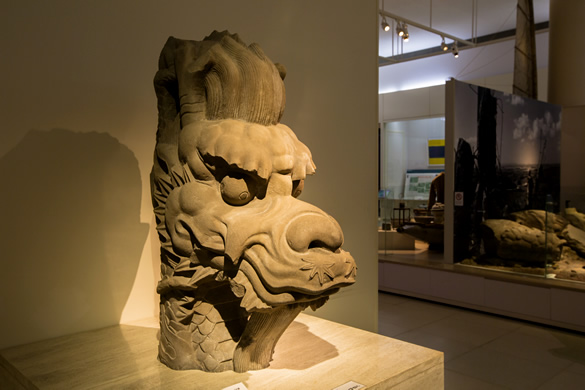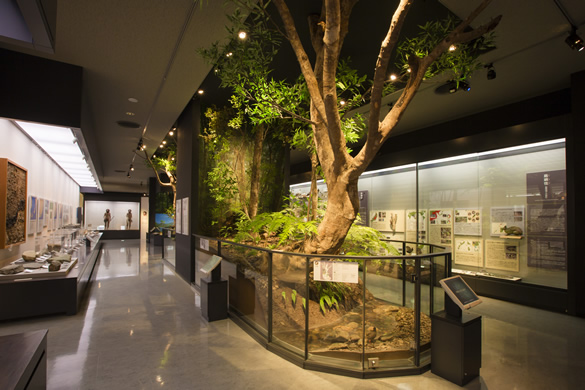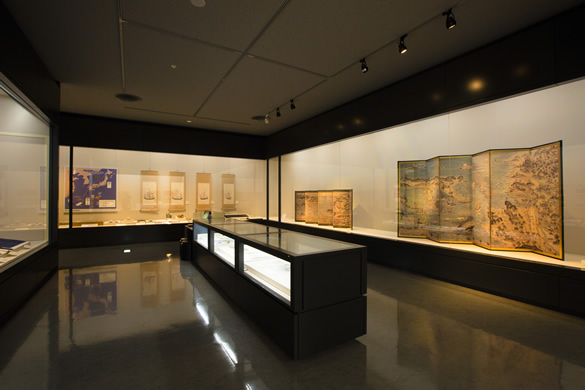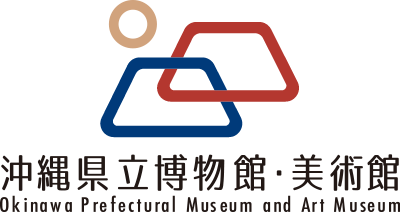Permanent Exhibitions
Since long ago, the islands of Okinawa Prefecture have been held in the sea’s embrace. This embrace, while intimate and close, simultaneously had far-reaching consequences. Bounded by the sea around it, Okinawa had the separation and autonomy to develop its own unique history and culture. Though Okinawa was constrained by the sea, it is also the sea that can be credited for Okinawa’s unique sense of expansiveness and connection. The sea surrounding Okinawa, and the Kuroshio current that runs northwards alongside the Ryukyu archipelago served as a vital highway to the wider world. Through this pathway, Ryukyuans were historically able to build close relations with other political entities in Asia and the wider Pacific region. These relationships provided a wealth of diverse cultural influences to the Ryukyuan people.
The islands of the Ryukyu Archipelago formed an important chain linkage in the Pacific region. Over the course of time, each island within the chain developed its own distinctive cultures and lifeways in response to its specific natural and social environment. Each island culture makes its unique contribution to the greater whole of Okinawa Prefecture’s collective natural, historical, and cultural heritage.
Under the general theme “Sea and Island Life — Seeking Prosperity, Beauty, and Peace”, the permanent exhibitions at the Okinawa Prefectural Museum & Art Museum seek to show how the people of Okinawa have lived — and continue to live — sustained by their islands and embraced by the sea.
The permanent exhibits take you on a tour of Okinawa’s past and present, from the blossoming culture of the Ryukyu Kingdom culture during the era of trade relations with To (China) and Yamato (Japan), to the dizzying changes experienced in the pre- and post-war eras, and on into the present.
The Museum’s permanent exhibitions include both general exhibitions and sub-exhibitions focused on specialized disciplinary fields and subject areas. All together, these exhibits offer a robust introduction to Okinawa’s distinctive nature, history, and culture. These exhibits are designed to be viewed through two complementary lenses: the Oceanic view and the Island view.
General Exhibitions

Welcome to the permanent exhibition in the Museum! As you approach the permanent exhibitions, you can experience the sensation of coming ashore onto an island with its fringing coral reefs and landward side lagoon (called the Ino) spreading out below you, which is visible in the see-through panels underneath your feet.
The front circular hall features images depicting the formation of the Ryukyu Archipelago and the evolution of its living creatures. This area features various fossils of whales, ammonites (extinct marine mollusks), and other creatures that used to live in the primeval sea. Further along in the exhibit, you will meet the Minatogawa people who lived in ancient Okinawa approximately 20,000 years ago and who are considered to be the ancestors of present-day Japanese people. You will also see some of the animal species of the Minatogawa era, including the Yanbaru Kuina (Okinawa rail) — a flightless bird endemic to Okinawa still alive today — and the now extinct Ryukyu-jika deer.
Under the overarching themes “A People Embraced by the Sea” and “Okinawa: From the Present to the Future”, the general exhibitions continue with examples of Okinawa’s abundant nature and the blessings of its surrounding ocean. The exhibits also showcase the history and culture that the ancestors of the Okinawan people created in their island environment.
In the Nature and Life on the Islands Section, you will find a large-scale diorama that offers a splendid panorama of the islands of the Ryukyu Archipelago. This archipelago stretches about 1,000 kilometers (620 miles) from Kagoshima Prefecture in the north to Taiwan in the south. Computer terminals are available nearby that put a wealth of information about the nature, history, and culture of the archipelago right at your fingertips. You will also have the opportunity to see a series of satellite images that provide aerial views of the islands within the archipelago.
Prologue: Nirai Kanai — Happiness and Plenty From the “Out Beyond”

Nirai Kanai was the Land of the Gods in Okinawan religion. Analogous to the concept of Heaven, it was a mythical paradise way out beyond the horizon and coral shallows, in which all of life and all of Okinawa’s natural blessings originated.
This image depicts the corridor as you enter the Museum’s permanent exhibitions. Gazing at the coral reef in the see-through panels underneath your feet, it is as if you are having the experience of coming ashore onto the island of Okinawa.
1. A People Embraced by the Sea

“Okinawa: Fantastic Treasure Trove of Fossils” in the Rotunda Exhibition.
In this section you can discover the fantastic treasure trove of fossils that exist in Okinawa. Ryukyu limestone, serving as the bedrock of the Okinawan islands, was formed by uplifted coral reefs. It is rich in calcium carbonate with high alkalinity, therefore making it extremely ideal for fossil preservation. That is why such a rich archaeological record exists in Okinawa.
As you enter the front circular hall, you will be greeted by a wide array of images depicting the formation of the Ryukyu Archipelago and the evolution of its living creatures. This area features various fossils of animals such as whales, ammonites (extinct marine mollusks), and other creatures that used to live in the primeval sea. Further along in the exhibit, you will meet the Minatogawa people who lived during the Paleolithic Period in Okinawa about 20,000 years ago and who are considered to be the ancestors of present-day Japanese people. You will also see some of the species of the Minatogawa era, including the Yanbaru Kuina (Okinawa rail) — a flightless bird endemic to Okinawa still alive today — and the now extinct Ryukyu-jika deer.
The front screen displays a video about the origin of the Ryukyu Islands, stretching from the Paleozoic era to the Present. It also depicts the arrival of living creatures and the lifestyle of people living in ancient times. This section invites you on a tour through time to experience Okinawa’s rich nature, history, and culture.
The Kogachibaru Shell Mound
The Kogachibaru Shell Mound is located in present-day Uruma City (in the Ishikawa area in the central part of Okinawa island). Working with items recovered from the archaeological digs at this site, we have created an exhibition depicting the lives of the Shell Mound Era people who lived in Okinawa approximately 4,000–3,500 years ago. Based on the excavation, we know that these people were hunters and gatherers who lived in small groups and built their pit dwellings on a limestone terrace facing the sea to the east. We can begin to imagine how the people during this Shell Mound Era lived based on their kitchen waste and other items they left behind in the shell mounds.
2. Social Transition from Shell Mound Era to Ancient Ryukyu Era

Moving away from strict reliance on hunting and gathering, people began to develop agriculture as a mode of economy around the 12th century. This started to create disparities and hierarchies within societal structures. The emergence of powerful local chieftains and warlords signifies the beginning of what is known as the Gusuku (Castle) Era. Local leaders and chiefs built fortifications (gusuku) to serve as sacred, administrative, and defensive centers. Some of the leadership began to establish tributary relations with Imperial China. This, in turn, brought increased trade and cultural exchange, ultimately becoming the basis for rising prosperity in the respective regions.
Repeated wars among the local chieftains ultimately resulted in the consolidation of power into three distinct principalities known as the Sanzan (“The Three Mountains” period): Hokuzan in Northern Okinawan, Chūzan in Central Okinawa, and the Nanzan in the South.
Then, in the early 15th century, power was further consolidated into one central, unified Ryukyu Kingdom by King SHŌ Hashi. After this consolidation of power, the 500-year history of the Ryukyu Kingdom began, with Shuri serving as the political and cultural center of the Kingdom.
3. Prosperity of the Kingdom

The Ryukyu Kingdom thus began its history as an independent nation. Domestic power rivalries brought the replacement of the relatively short-lived First Shō Dynasty with a much more permanent Second Shō Dynasty. By the beginning of the 2nd Shō Dynasty, Ryukyu had firmly established itself as a key member of China’s wider Sakuhou investiture and tributary orbit. Between the 14th and the 16th century, the Ryukyu Kingdom maintained regular trade relations with China, Japan, Korea, and it even established trade relations as far away as Southeast Asia. Thus began a golden age of trade relations.
The old Shuri Castle Main Hall Bell, part of the permanent collections at the Okinawa Prefectural Museum & Art Museum, is a precious reminder of that golden age of the Ryukyu Kingdom. Created during the ascent of Ryukyu’s power, the bell is a lasting testament to the glory of the Kingdom which was overflowing with splendid riches from abroad and had ships calling at ports all over Asia. This bell is also known as the “Bridge Between Nations” Bell (万国津梁の鐘, Bankoku Shinryō no Kane). It has a famous inscription etched in its side, the words of which detail how the Ryukyu Kingdom played a pivotal role in the region, seeking to serve as a “Bridge Between Nations” during that period.
This exhibition seeks to showcase that prosperous period when the Ryukyu Kingdom was at the height of its power, building for itself a strong national identity based on the prosperity that flowed from its position as a leading East Asian maritime trading nation.
4. Satsuma Control over the Ryukyus and the Kingdom

In 1609, troops of Lord Shimazu of the Satsuma feudal domain in southern Kyushu Japan invaded the Ryukyu Kingdom and brought it under the control of the Japanese Tokugawa shogunate. During this period, however, the Ryukyu Kingdom was largely able to maintain its internal organization and the long-standing relationship that it had established with China remained uninterrupted. Thus, the Ryukyu Kingdom began a period of dual relations with both China and Japan.
During this period, the Ryukyu Kingdom was managed under the strong leadership of skilled and powerful politicians such as HANEJI Choshu and SAI On. These leaders established a stability that allowed for the further refinement of the culture of the Ryukyu Kingdom.
During this time of continued stability, many splendid Ryukyuan craft specialties, such as lacquerware, were developed and perfected under the guidance of the Kaizuri (Crafts) Magistrate’s Office. In addition, documents such as the Chūzan Seikan (中山世鑑, “Reflections on Chūzan”) and Kyūyō (球陽, historical texts) that depicted the first official, authentic history of the Ryukyu Kingdom were edited during this period.
5. Decline of the Kingdom

Maintenance of relations with both China and Japan allowed for the continued sustainment of the Ryukyu Kingdom as a nominally independent country. Moving into the 19th century, however, contradictions and conflicts began to arise. Poverty within the farming villages impacted the finances of the central Ryukyu government in Shuri and hindered the administration of the Kingdom. Foreign pressures compounded these domestic difficulties, and Ryukyu began to fall prey to the ambitions of western powers that were competing to exploit new markets in Asia. In response to both internal and external pressures, the Kingdom began to enter a time of crisis.
6. Modern Era of Okinawa

In 1879, the new Meiji government of Japan formally abolished the Ryukyu Kingdom, putting a final end to its 500-year history as an autonomous country. Ryukyu then became incorporated into the Japanese nation-state as Okinawa Prefecture. Despite this governmental shift, pre-existing institutions and social arrangements from the Ryukyu Kingdom period were left intact for some duration of time in order to maintain social stability. As a result, land reforms and the establishment of private property rights, as well as participation in the national census, were also deferred. However, by the beginning of the 20th century, an industrialized and capitalist economy was growing and a national educational system had more fully established itself in Okinawa. Increased participation in a more far-reaching global marketplace also began to impact the cultural and economic realities of life in Okinawa. During WWI, demand for sugar rose creating an economic boom for the sugar industry in Okinawa. Okinawan farmers began to increasingly focus on sugar cane production, and less on growing rice and potatoes for local consumption.
Dependence on sugar production and a cash economy, however, proved risky. During the final years of the Taisho era (1920s), demand for sugar decreased due to a shifting global market, and Okinawans suffered a severe economic depression. This forced many Okinawans to turn to the sotetsu (cycad), a palm-like plant native to Okinawa, as an emergency source of food in order to avoid starvation. Sotetsu is a dangerous food source, however, requiring a labor intensive preparation process to remove its toxic component so that it becomes safe for human consumption. This time in Okinawan history came to be known as the “Sotetsu Jigoku” (Cycad Hell). Okinawans suffered miserable conditions and multiple hardships during this period: enduring institutional reform after the dissolution of the Ryukyu Kingdom, famine conditions, heavy taxation by Japan, and a series of natural calamities such as typhoons and drought. Many Okinawans were forced to migrate to mainland Japan or overseas in an effort to avoid starvation and seek better economic opportunities.
Then, because of Japan’s imperialist, expansionist policies in East Asia, Okinawa became caught up in war-time activities. In 1945, the Okinawan people suffered from a furious land battle between Imperial Japan and the United States of America. This was known as the Battle of Okinawa, and it caused the tragic loss of more than 200,000 precious human lives. During the devastating Battle of Okinawa, a great number of valuable cultural treasures were also lost to explosions and fires.
7. Okinawa after the War

Okinawa suffered terrible losses, both in human and material terms, during the Battle of Okinawa. The people of Okinawa Prefecture had to start their lives over again from almost nothing after the war. Governmental authority in the Prefecture was transferred from Japan to the United States after World War II. This period of American control lasted for 27 years (until 1972). The United States government regarded Okinawa as a valuable strategic military asset in East Asia, but at the same time, it made efforts to develop Okinawa’s industry and improve educational opportunities and social welfare during the post-war period. These efforts also resulted in building a base-dependent economy. As the military bases expanded, however, the hardships that Okinawans had to endure also continued. This dynamic was a catalyst for urging the return of Okinawa to Japanese governmental control. Japan regained governmental control of Okinawa in 1972. Efforts were made to improve the economy of Okinawa so that it would match that of mainland Japan, but numerous unresolved problems are the same as before, including the many remaining military bases. While burdened with these problems, present-day Okinawans seek peace and engage in activities that try to make the best of their circumstances while striving to let their distinctive Okinawan cultural inheritance shine through.
Epilogue — Okinawa: From the Present to the Future

After Okinawa’s reversion to Japan, the natural landscape of Okinawa was dramatically transformed by a variety of developments. As Okinawa was continuing to experience radical transformations in response to sweeping societal changes, the leaders of the world’s major industrial countries decided to gather together in Okinawa for the 2000 Kyushu-Okinawa Summit. That same year, a group of historical sites from the Ryukyu Kingdom era were selected to be added to the list of World Heritage Sites under the name of “Gusuku Sites and Related Properties of the Kingdom of Ryukyu”. Through these important designations, the greatness of Okinawan culture was formally recognized by the wider world. The number of tourists visiting Okinawa and the number of people who have decided to move to Okinawa have soared, and now Okinawa is poised to enter a new era.
This epilogue in the exhibit, entitled The Present Life of Okinawa, consists mainly of photographs contributed to the museum by everyday residents of the Prefecture. These materials are a true documentary record of life in Okinawa today.
Sub-Exhibitions

Special field exhibitions are displayed in the five sub-exhibition rooms arranged around the main general exhibition area in the Museum. These five sub-exhibitions of the Museum center on these five fields: natural history, archeology, arts and crafts, history, and folklife. These sub-exhibitions draw from the Museum’s collection to delve more deeply into the topics and themes touched on in the general exhibitions. The topics and themes of the sub-exhibitions are continually changed in order to assure variety and spark interest — and to keep visitors coming back for more visits.
Sub-section 1: Natural History Gallery
“The Story of life in Okinawa over a Period of 200 Million Years”

This exhibition showcases the formation of the Ryukyu Archipelago and the unique ways that its plants and animals have evolved and adapted to their specific island environments. This exhibition also presents the most current research on Okinawa’s world-famous human fossil, the Minatogawa Man. Also in this section, you can see large-scale dioramas that represent mangroves, the forests of Yanbaru (northern part of Okinawa Island), Miyako Island, and Iriomote Island. These displays illustrate the origins and formation of Okinawa’s natural environment.
Sub-section 2: Archaeology Gallery
“The World of Okinawa Archaeology”

Diorama of the Yanbaru Forest at night
Utilizing items excavated from archaeological sites throughout Okinawa Prefecture, this exhibition introduces us to the lives of ancient Okinawans, showing regional characteristics and cultural evolution through history, all in an easily understood manner.
In this section of the museum, you will have the opportunity to see a wide variety of displays featuring interesting artifacts that help to tangibly illustrate these historical changes. You can begin to understand the ways in which Okinawa and the Sakishima Islands had different cultural spheres during ancient times. You can see a representative sampling of ceramics that convey just how robust and far-reaching the trade network of the Ryukyu Kingdom was. You can see WWII relics uncovered from battle sites, such as artillery casings and medicine bottles. You will also have the opportunity to see the mysterious Senkoku-Sekiban petroglyph tablets that were uncovered from archaeological sites throughout Okinawa. They have been engraved with imagery and symbols whose meaning and origin remain a mystery.
Sub-section 4: History Gallery
“History from More than Books”

From its time as the independent Ryukyu Kingdom to the present day, Okinawa has undergone enormous changes as a result of the changing public policies of mainland Japan, America, and other actors on the international stage. In the History sub-exhibition room, visitors will have the opportunity to see a variety of objects that reflect these changes, and have the opportunity to “read” the history of Okinawa as relayed to us by historical objects. Could there be a more enjoyable way to experience history?
These exhibitions will rotate several times a year in response to emerging topics and themes.
Sub-section 3: Arts and Crafts Gallery
“The Beauty of Ryukyu”

Diorama of the Yambaru Forest at night
Over time, the people of the Ryukyu islands have formed their own distinctive aesthetic in response to their unique history as a maritime trading nation. Expertly weaving together diverse cultural influences, they created a range of splendid new cultural forms. In its own distinctive way, the Ryukyu Kingdom created a vibrant arts and crafts culture.
In this exhibit, you will be able to get a sense of the exquisite taste of the people of the Ryukyu Kingdom. To make the exhibitions even more enjoyable and accessible to us in the present, the exhibits are routinely rotated and displayed under new themes.
Be sure to stop by the exhibit and experience the beauty of the Ryukyus.
Sub-section 5: Folklore Gallery
“Tradition and Life in Okinawa”

This subsection introduces us to the folk heritage of the Ryukyu islands. Folk culture simultaneously shapes, and is shaped by, everyday life. Folk culture expresses itself in a variety of ways. It can be seen in farming and fishing practices, foods, clothing, lodging, trade-craft, rites of passage, funerary and burial practices, and societal organization.
This subsection is designed to express the full range of everyday cultural activities and illustrate the richness of Okinawan folk culture. Its aim is to take you to the very heart and soul of everyday life in the Ryukyu Islands.
Outdoor Exhibits

Let’s step outside to experience the outdoor exhibits. The museum’s outdoor courtyard includes restorations of a traditional Okinawan home and storehouse. This outdoor exhibit is ideal for field trips and study tours.
Outside you will also find the historic Wakuta Kiln. This was an actual kiln that was at the center of the pottery industry in Okinawa during the 17th century and is considered to be the origin of Okinawan pottery making which continues to this day. The Wakuta Kiln was excavated and moved to the Museum from its original location near the Okinawa Prefectural Office in the Izumizaki area of Naha.
Finally, as a further extension of the outdoor exhibits, you are invited to enjoy the native flora and fauna planted around the periphery of the courtyard of the Museum.
Hands-On Room

In the Touch and Experience (Hands-On) Room, visitors can choose from 37 different “experience kits” to encourage learning through hands-on activities. The activity kits generally fall under two themes: The Workings of Nature and The Wisdom of our Ancestors.
These interactive learning experiences are linked to subjects that you will see exhibited in more depth within the permanent exhibitions, featuring topics like Forest Animals and Fishy Friends of the Coral Reef. You can also try your hand at building a Gusuku (“castle”) wall, utilizing the piled-stone technique.
This hands-on space is a great entry point to the museum for children, sparking their curiosity, and encouraging them to explore the rest of the exhibitions.



